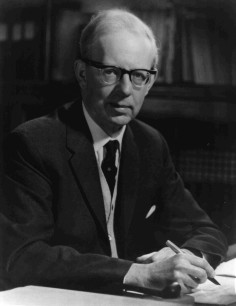
BIOGRAPHY OF EDMUND CLIFTON STONER ( 1899 - 1968 )
-
born Oct. 02, 1899, East Molesey, Surrey, England.
died Dec. 27, 1968, Leeds, England.
|
|
BIOGRAPHY OF EDMUND CLIFTON STONER ( 1899 - 1968 )
died Dec. 27, 1968, Leeds, England. |
EDMUND CLIFTON STONER ( 1899 - 1968 ), the british physicist, one of the founders of the physics of magnetism, in particular, the magnetism of metallic substances. His works lead to the formulation the first workable model of the magnetism of band or itinerant electrons, the so-called STONER MODEL.
Stoner was born in East Molesey, Surrey and educated at Bolton Grammar School, 1910-1918, and Emmanuel College, Cambridge, 1918-1921 where he read for the Natural Sciences Tripos specialising in physics. In 1919 he developed diabetes which entailed a restricted diet and varying periods of hospitalisation before a regular insulin regime became possible in 1927. He worked with Rutherford as a graduate student at the Cavendish Laboratory, Cambridge from 1921 to 1924 when he was appointed Lecturer in Physics at Leeds University. He remained at Leeds for the rest of his life, as Reader in Physics, 1927-1939, Professor of Theoretical Physics, 1939-1951, and Cavendish Professor of Physics, 1951-1963, in succession to R. Whiddington (q.v.). For most of his life (he married in 1951) Stoner was solely responsible for his ageing mother and this, taken together with his diabetes, restricted much of his activity to Leeds, and he undertook few outside activities. His research interests were in magnetism and low temperatures.
The main achievements of E. Stoner are the formulation of a criterion of the ferromagnetism of the free Fermi gas (Stoner criterion 1936) and method which relate the Weiss molecular field with the band structure of a substance.
Stoner theory was first developed in Leeds in the 1930's. The theory of ferromagnetism prevalent in this period was that developed by Heisenberg. This involved localized electron in direct exchange interaction. This Heisenberg model was of course designed to give a physical interpretation of the molecular field proposed at 1907 by Weiss. For non-metals such as ferrites the model is suitable very well. For metals, however, the works of Slater and many others had demonstrated that the d-electrons of nickel and iron have energy levels distributed quasicontinuously in energy bands leading to a situation which can not be described by the Heisenberg model.
STONER MODEL gave an alternative to the Heisenberg model; it continue to use the Weiss molecular field hypothesis, even without clear justification how to interpret this field under conditions of delocalization. Stoner insisted that the density of states of the non-localized electrons must enter the formalism centrally. This is the basis of the STONER MODEL.
Life and Works of E. C. STONER and his contribution to Magnetism: http://www.ast.leeds.ac.uk/~knapp/Stoner/E.C._Stoner.html
BIOGRAPHY of E. C. STONER (Leeds University Page).
BIBLIOGRAPHY of E. C. STONER (Leeds University Page).
Papers and correspondence of Edmund Clifton Stoner, 1899-1968.(Bath University Page).
BOOKS:
Stoner, Edmund C. MAGNETISM AND ATOMIC STRUCTURE. 1926
Stoner, Edmund C. MAGNETISM AND MATTER. 1934
For the informative discussion of the collective (itinerant) model of magnetism, see papers:
K.L. Hunt, Collective Electron Ferromagnetism: A Generalization of the Treatment and an Analysis of Experimental
Results. Proc. Roy. Soc. v.A216, p.103 (1953).
E.P. Wohlfarth, The Theoretical and Experimental Status of the Collective Electron Model of Ferromagnetism.
Rev. Mod. Phys. v.25, No 1, p.211 (1953).
C. Tannous, J. Gieraltowski, The Stoner-Wohlfarth Model of Ferromagnetism.
Eur. J. Phys. v.29, p.475 (2008).
| Magnetic states |
| diamagnetism – superdiamagnetism – paramagnetism – superparamagnetism – ferromagnetism – antiferromagnetism – ferrimagnetism – metamagnetism – spin glass |